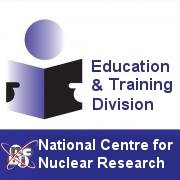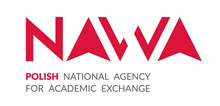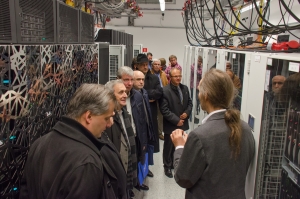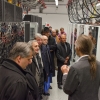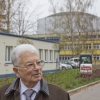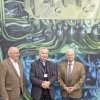NCBJ wants to participate in development of new research facility in Russia
2017.11.09 10:08 - Marek PawłowskiNCBJ is interested in the NICA project run in Joint Institute for Nuclear Research in Dubna, Russia (JINR). On the first day of 2nd international conference NICA Days 2017 held in Warsaw (November 6-10), a consortium of Polish research institutions interested in the project was established. On November 8 conference attendees were given an opportunity to visit some NCBJ labs in Świerk that may contribute to the project.
NICA (Nuclotron-based Ion Collider fAcility) will be a new accelerator complex developed to study properties of dense baryonic matter in Joint Institute for Nuclear Research in Dubna, Russia (JINR), an international organization of which Poland is a member. Numerous Polish research institutions, including NCBJ, want to participate in the project. Therefore Warsaw University of Technology (PW) jointly with NCBJ and other partners organized in Warsaw 2nd international conference for both NICA developers and future users (NICA Days 2017, November 6-10). A consortium of Polish research institutions interested in the project was established on the first conference day. Consortium members include PW, NCBJ, Jan Kochanowski University in Kielce (UJK), and Warsaw University (UW).
On November 8 conference attendees were given an opportunity to visit some NCBJ labs in Świerk. Guests from Dubna including some JINR Managers responsible for the NICE project were presented some capabilities of the labs potentially useful in the project. NCBJ Nuclear Equipment Division (ZdAJ), manufacturer of medical and industrial accelerators, is producing unique elements for European large research facilities including CERN Geneva, XFEL Hamburg, ESS Lund. Assets presented to the guests include ZdAJ’s park of CNC machine tools used to produce accelerating structures for the Linac 4 accelerator, a part of the accelerator chain supplying LHC in Geneva. The guests visited also NCBJ material research lab (capable to study engineering materials exposed to high levels of ionising radiation), detector lab, electronics lab (that has produced control circuitry for XFEL, and currently is producing electronic circuits for ESS).
The NICA accelerator complex will accelerate ions of various light and heavy elements (e.g. gold), polarized protons, and deuterons. Particle collisions will take place inside two detectors: the MPD general purpose detector and the SPD detector dedicated to investigate collisions of polarised protons/deuterons. Major scientific objective of the project is to investigate quark-gluon plasma, i.e. matter in hot and dense states in which individual nucleons cannot survive. Researchers expect such plasma will be produced in the collisions. Studying particles emitted from the collision area and revealed by the surrounding detectors, physicists should be able to discover yet unknown properties of such states of the matter.
Huge amount of data acquired by the detectors will need plenty of computing power to be efficiently acquired, stored, and processed. Data acquired in similar experiments run in CERN are analysed in many High Performance Computer (HPC) centres scattered all over the world, including NCBJ Świerk Computer Centre (CIŚ) also visited by NICA conference attendees. CIŚ computing power is also used by NCBJ engineers to perform calculations indispensable to correctly design accelerating structures, by physicists to run theoretical models in order to predict properties of short-lived isotopes (knowledge of the properties helps to plan experiments, in which the isotopes are produced) etc. CIŚ infrastructure, know-how and competences of its staff extend perspectives of the NCBJ / NICA cooperation.
Potential contribution of NCBJ and other Polish research institutions to the NICA project will be analysed in detail during the coming months. The consortium established on November 6 is going to streamline and coordinate these works.
The group of visitors to Świerk included: Prof. Richard Lednicky, JINR Deputy Director; Prof. Alexander Sorin, JINR Scientific Secretary; Dr. Dmitri Peshekhonov, JINR- LHEP Lab Scientific Secretary; Prof. Itzhak Tserruya, Chairman of the JINR Advisory Committee on High Energy Physics Scientific Programmes; Dr. Borys Starchenko, JINR press secretary; DSc. Adam Kisiel, PW President’s Proxy for contacts with PW graduates and prospective employers; DSc. Tomasz Starecki, Director of the PW Institute for Electronics Systems in the Faculty of Electronics and Information Technology; DSc. Krzysztof Poźniak from PW; and DSc. Maciej Rybczyński from UJK.
Prof. Jurij Oganessian, world-class expert on super-heavy elements for whom the heaviest element synthetized so far by the JINR team was named oganesson (Og, Z=118) in 2016, was a special guest in Świerk. Prof. Oganessian visited NCBJ Department of Education and Training (DEiS). At the end of the visit he expressed warm congratulations for Prof. Ludwik Dobrzyński, DEiS Director. Our distinguished guest said he had visited many scientific institutions in the world, but in none of them activities of the unit dealing with education/training were conducted so effectively, on a day-to-day basis rather than occasionally, and on a such high academic level.


